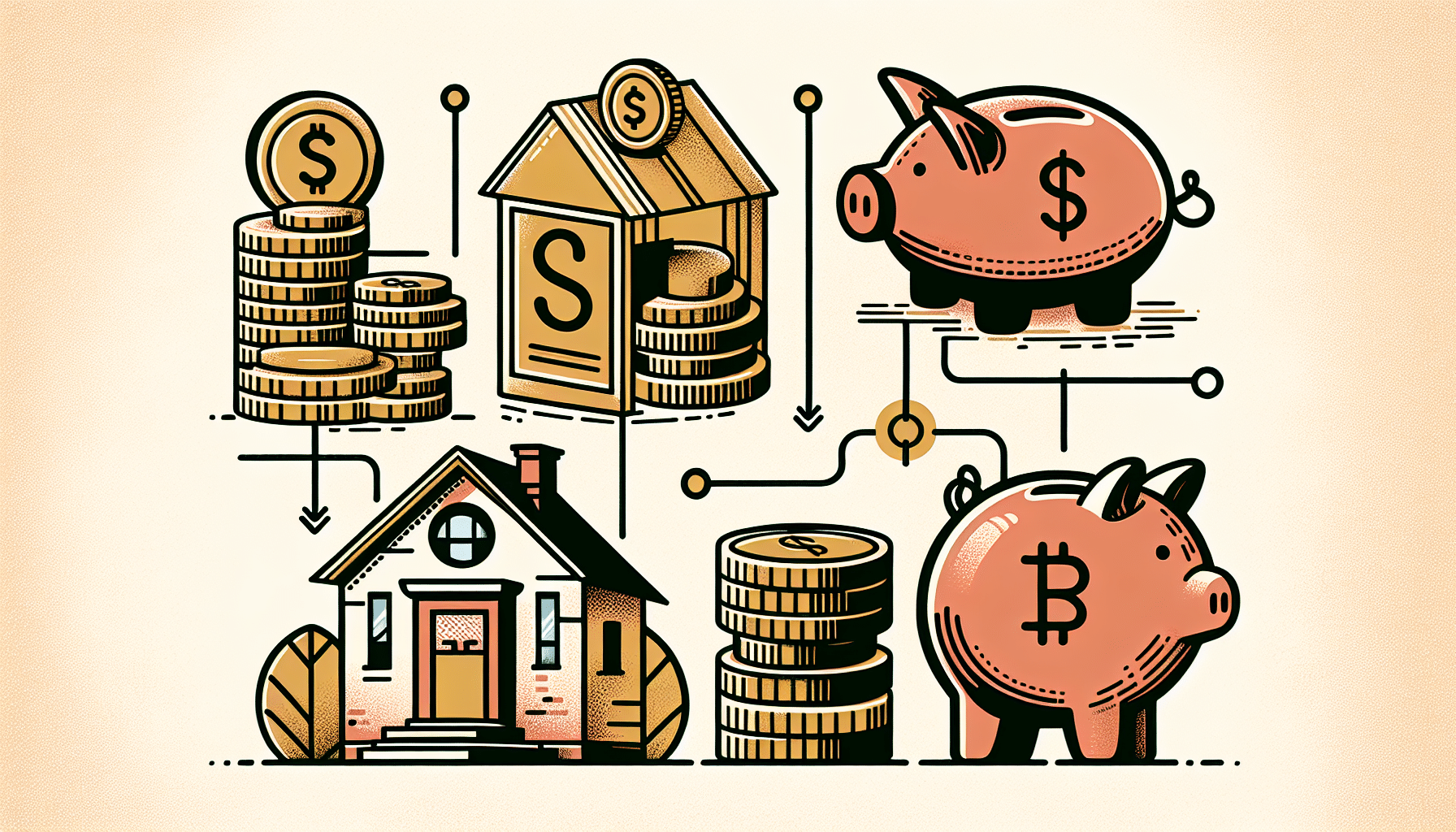Saving for a down payment can be the biggest challenge on the road to homeownership. Cut through the complexity with focused strategies that move the needle. This article distills down payment saving strategies into digestible, actionable advice, helping you navigate through budgeting, cutting expenses, and using financial tools to your advantage. Prepare to empower your savings with guidance tailored for the future homeowner.
Key Takeaways
- A sizeable down payment reduces upfront fees, interest rates, and monthly mortgage payments, and eliminates the need for PMI. It’s essential to also save for associated costs like closing costs beyond the down payment.
- Smart saving strategies for a down payment include budgeting wisely, trimming unnecessary expenses, and generating extra income through side gigs or sales.
- Various financial tools such as high yield savings accounts, money market accounts, and Certificates of Deposit (CDs) can help grow down payment savings securely, with some offering higher interest rates and federal insurance.
Establishing Your Down Payment Goal
As the first step in the home buying process, establishing a down payment goal is crucial. As banks typically prefer borrowers to contribute at least 20% of a home’s purchase price as a down payment, setting a goal becomes essential. A sizeable down payment can significantly:
- Lower upfront fees
- Lower interest rates
- Lower monthly mortgage payments
- Eliminate the need for Private Mortgage Insurance (PMI)
Remember, this goal isn’t just about the down payment; it also involves saving for associated costs, such as closing costs and the monthly payment.
Assessing Home Affordability
Before embarking on your saving journey, understanding home affordability is critical. Consider the following:
- The 28/36 rule suggests that no more than 28% of gross monthly income should go toward housing costs, including your monthly mortgage payment.
- Mortgage affordability calculators can provide personalized estimates and help set a realistic expectation for the down payment needed.
- Don’t forget to factor in additional costs like property taxes and homeowners insurance.
Considering Loan Options
Various loan options can influence your down payment goal. For instance, first-time home buyers may benefit from lower down payment options, which can range from as little as 3% for a conventional loan to $0 down for USDA and VA loans, depending on their credit score and income. Exploring these options can help you choose the best fit for your financial situation.
Factoring in Closing Costs
Closing costs are a crucial factor to consider in your savings plan. These costs range from 2% to 5% of the home’s purchase price and include fees for:
- credit checks
- title searches
- appraisals
- inspections
- attorney fees
- loan origination fees
- recording fees
- escrow fees
- prepaid expenses (such as property taxes and homeowners insurance)
Make sure to budget for these costs when saving for a house and planning to buy a home.
Remember, certain down payment assistance programs allow the funds to be used not just for the down payment but also for closing costs.
Smart Savings Tactics for Accumulating Your Down Payment Fund

Once you’ve set your down payment goal, it’s time to devise a smart savings strategy. Tactics such as budgeting, cutting unnecessary spending, and generating extra income can aid in the accumulation of your down payment fund.
Budgeting Wisely
Budgeting plays a pivotal role in attaining your down payment goal. By allocating each dollar a role, you ensure that you’re aware of where money is spent. Monthly budgets should outline all income and expenditures, designating a specific portion towards your down payment.
Remember, budgeting also includes repaying debts, which is key to managing finances.
Trimming Unnecessary Spending
Another effective approach to boosting your down payment savings is by trimming unnecessary spending to save money. This could involve eliminating non-essential subscription services or reducing frequent expenses like coffee runs. Even small changes can add up to significant payment savings over time.
Generating Extra Income
In addition to budgeting and cutting unnecessary spending, generating extra income can also contribute to your down payment fund. This could be achieved by engaging in side gigs, selling items, or even negotiating for a raise at work.
Financial Tools and Accounts for Your Down Payment Savings
Now that you’re saving, it’s time to consider where to park these funds. Certain financial tools and accounts can help grow your down payment savings. These include high yield savings accounts, money market accounts, and Certificate of Deposits (CDs).
High Yield Savings Accounts
High yield savings accounts can offer:
- 10 to 20 times as much interest as regular savings accounts
- Faster wealth accumulation
- Better interest rates
- Total liquidity
- Easy access to funds when required, especially when using a linked savings account
Money Market Accounts
A money market account often requires a higher minimum balance but offers convenient features for account holders. These money market accounts are federally insured, ensuring safety up to $250,000 through the FDIC for banks or the NCUA for credit unions.
Certificate of Deposits (CDs)
CDs offer higher interest rates than traditional savings accounts, making them a potentially lucrative option for those with a longer savings timeline. Despite having lower earning potential compared to volatile investments like stocks, CDs are more secure and offer a guaranteed rate of return.
Leveraging Assistance Programs for Your Down Payment

While saving for your down payment, consider leveraging assistance programs. These programs, offered by various levels of government, can help home buyers with down payments and closing costs.
Federal and State Programs
Federal and state programs offer financial aid through loans and grants for eligible homebuyers, including usda loans. From special savings accounts with tax advantages to Individual Development Accounts (IDAs), these programs can significantly aid your home buying process.
Employer-Assisted Housing
Employer-Assisted Housing (EAH) programs provide down payment assistance to employees as a benefit or retention strategy. Major corporations, the United States Federal government, and the Federal Housing Administration offer these programs to help employees overcome housing affordability issues.
Managing Debt to Maximize Savings

While saving for a down payment, managing debt efficiently is crucial. High-interest debt can severely limit one’s ability to save adequately for a home down payment.
Reducing High-Interest Debt
High-interest rates on debts can divert funds that could contribute to a down payment. By paying off high-interest debts first, you can increase financial flexibility and reduce financial stress.
Balancing Debt Obligations
Balancing debt obligations is a delicate art. It involves:
- Creating a budget
- Considering debt consolidation options
- Ensuring an emergency fund
- Contributing to retirement savings
- Focusing on down payment savings
- Debt repayment
These steps are crucial for financial stability.
Automating Your Savings Journey
Automation is a potent tool in your savings journey. By setting up automatic transfers to a savings account, you ensure consistent growth of the down payment fund without manual intervention.
Protecting Your Down Payment Savings
As you build your down payment fund, protecting your savings is crucial. An emergency fund acts as a financial safety net, providing a cushion to cover unexpected costs without needing to incur debt.
Creative Ways to Boost Your Down Payment
Apart from the traditional saving strategies, there are creative ways to boost your down payment. These include selling valuable personal assets, using a windfall like an inheritance, or even starting a crowdfunding campaign.
Summary
In conclusion, saving for a down payment is a journey that requires planning, discipline, and smart financial strategies. From establishing a down payment goal to leveraging assistance programs, every step is crucial in the home buying process. Remember, the journey might seem challenging, but with each step, you’re closer to owning your dream home.
Frequently Asked Questions
To buy a $500,000 house, aim to save at least $100,000 for a 20% down payment, which can help you avoid additional costs such as private mortgage insurance. You should also consider saving an additional amount for closing costs, totaling approximately $27,500 to $28,750.
You don’t have to pay a 20% down payment for a house anymore. Some mortgage lenders allow down payments as low as 3%. For instance, Chase Bank’s DreaMakerSM loan and Ally Bank’s HomeReady loan both allow homebuyers to put down just 3% of the home’s price.
Most people save for a down payment by choosing high-yield savings accounts, money market accounts, or CD deposit accounts, as these options offer growth potential and protection for their savings. Additionally, cutting back on spending can help accelerate the saving process.
Here are six tips to save for a down payment: 1. Develop a budget and timeline 2. Establish a separate savings account 3. Shop around to reduce major monthly expenses 4. Monitor your spending 5. Look into state and local home-buying programs 6. Celebrate savings milestones.
A high yield savings account can help you save for your down payment by offering a higher interest rate than a regular savings account, allowing your fund to grow faster.




